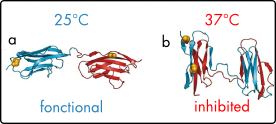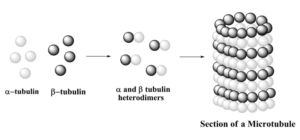Temperature control for S. pombe yeast cell cycle studies
Working with S. pombe is working with one of the most powerful tools in genetics. You can scan all aspect of cell division, microtubule assembly, cell polarity and do phenotype-genotype analyses in a science minute! Experiments go faster in fission yeast, it is the beauty of this model. So how about going even faster in your research?.
Schizosaccharomyces pombe
S. pombe is an african fission yeast isolated in 1893 from millet beer. It is a unicellular eukaryote organism with a caracteristic rode shape. S. pombe diameter is around 3 micrometers and depending on its cell cycle phase status, and a cell can measure between 8 and 13 micrometers. With a short generation time of 2 to 4 hours and straightforward genetics, S.pombe was at the origin of groundbreaking work on cell cycle regulation.

Ultra fast temperature shift device for in vitro experiments under microscopy
Use of temperature-sensitive mutant in S. pombe fission yeast for live-cell imaging
During S. pombe division, the Cdc25 protein is required for mitotic entry. In Cdc25 thermosensitive mutants, the Cdc25 protein is functional at 25°C (Fig. 1a) but over 37°C it becomes non-functional or inactivated (Fig. 1b). Using Cdc25 t.s mutants allows for a reversible cell cycle arrest at the G2/M transition and a synchronous re-entry into the cell cycle upon shift to permisive temperature.

References
- B. Alberts et al., Molecular Biology of the cell, 4th edition
- P Nurse, P. Thuriaux, et al., Genetic control of the cell division cycle in the fission yeast Schizosaccharomyces pombe, Molec Gen Genet, 1976
- M. Mitchison, The biology of the cell cycle. Cambridge University Press, 1971
FAQ
Schizosaccharomyces pombe is a type of fission yeast. It was first isolated from millet beer in Africa in 1893\. This organism is a unicellular eukaryote. It is identified by its characteristic rod shape. The diameter of the yeast cell is around 3 micrometres. Its length is variable and depends on its status in the cell cycle. A cell can measure between 8 and 13 micrometres long. S. pombe is recognized for having a short generation time, which is two to four hours. This, combined with its direct genetics, made it suitable for foundational research. It was used in important studies concerning cell cycle regulation. The organism is used to study cell division, cell polarity, and microtubule assembly.
S. pombe is considered a useful organism for genetic research. It has a short generation time, lasting only two to four hours. Its genetics are also considered simple and direct to work with. These features allow experiments to be conducted quickly. The organism has been used for important foundational studies on the regulation of the cell cycle. Researchers use this yeast to examine many different cellular processes. These studies include cell division, the assembly of microtubules, and cell polarity. It is also applied in phenotype-genotype analyses. The speed of conducting experiments in fission yeast is noted as a benefit for research.
A thermosensitive, or ts, mutant is an organism used in research. An example in S. pombe is the Cdc25 ts mutant. In these mutants, a specific protein’s function is dependent on the temperature. The protein is functional at one temperature, which is called the "permissive" temperature. For the Cdc25 mutant, the permissive temperature is 25°C. At this temperature, the protein works as normal. However, the protein becomes non-functional, or inactivated, when moved to a different temperature. This is known as the "restrictive" temperature. For Cdc25, this inactivation occurs at temperatures over 37°C. This property allows researchers to control the protein’s function by changing the temperature.
The Cdc25 protein is required for the cell to enter mitosis. Researchers use Cdc25 thermosensitive (ts) mutants to control this step. When the yeast cells are moved to the restrictive temperature (over 37°C), the Cdc25 protein is inactivated. This inactivation causes a cell cycle arrest. The arrest specifically happens at the G2/M transition. This effect is reversible. If the cells are shifted back down to the permissive temperature (25°C), the protein becomes functional again. This allows the cells to re-enter the cell cycle. A main benefit of this method is that it creates a synchronous re-entry. All the cells in the culture can be made to enter the cell cycle at the same time, which is useful for study.




